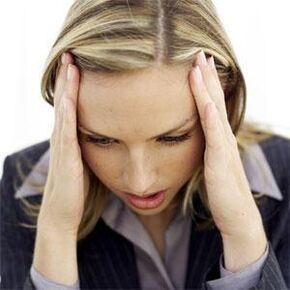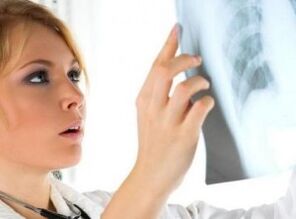Osteochondrosis today is rightly considered to be the "illness of the century", because more often than not, people are suffered by people whose work does not require increased motor activity.
In most cases, changes in cartilage and bone tissue are observed in working age - up to 40 years.
The disease can affect different parts of the spine, and the second more dominant is osteochondrosis in the cervical region.
What is this?
Osteochondrosis is dystrophic disorders of articular cartilage and adjacent bone tissue.
Previously, the term has extended to a large group of bone artificial diseases, but now it is only used with degenerative vertebral disease.

Compared to the other departments of the spine, the cervical region is the most mobile and has many nerve and vascular formations.The structure of the vertebrae is small, as well as the fact that they are surrounded by a fairly low muscle corset.
Such an anatomical structure predisposes to the development of osteochondosis, the severity of clinical manifestations on which depend on the nature of changes in intervertebral discs and the degree of destruction.
The causes of the development of the disease
The main and common cause of osteochondrosis of the cervical column is a sedentary lifestyle.
Due to the lack of physical effort with a sedentary and seated lifestyle:
- Metabolic processes are raped;
- The level of salts in the blood circulation and the lymphatic fluid increases;
- In the cervical region, in the kidneys and the liver of the spine, salts are laid.
Damage to cervical vertebrae is determined mainly by a lack of nutrients in the intervertebral discs.Consequently, the main reasons for the occurrence of cervical osteochondosis also include incorrect and unbalanced nutrition.
Risk factors
There are many risk factors for cervical osteochondosis.

The most common factors are:
- heredity;
- age -related changes;
- injuries of the cervical column;
- hypothermia;
- hormonal disorders that lead to metabolic disorders;
- Certain autoimmune diseases that cause damage to the cartilage fabric (systemic lupus erythematosus, rheumatism).
What is dangerous
Not only does the spinal cord and nerve roots pass through the cervical column, but also the vertebral artery, which is responsible for the supply of the blood of the back of the brain, an oblong brain and a cerebellum.
Consequently, with cervical osteochondosis, this artery is pressed and, consequently, a violation of brain traffic.
In particularly advanced cases, the compression of the artery and adjacent blood vessels and nervous plexus can result in consequences such as:
- violation of coordination;
- decrease in hearing and vision;
- stroke.
If you do not heal the disease at the initial stage, this can lead to complications such as: the projection of the intervertebral disc or the hernia of the intervertebral disc.
The degree of disease development
Cervical osteochondosis, such as osteochondrosis of other columns, develops in stages.There are 3 steps in the development of the disease.
1 degree
It is characterized by the beginning of the destruction of intervertebral discs.
The cracks are formed in the fibrous ring, the resistance and elasticity of the disc form, its height decreases, because of which the nerve roots are pressed.
Characteristic painful pain appears.Sometimes, at 1 stage (preclinical), such pain can be absent, and osteochondrosis takes place with moderate discomfort in the neck.
2 degrees
If 1st degree osteochondrosis has not been treated or if the treatment was not effective, then a chronic condition occurs, which is the 2nd degree of osteochondrosis.
The pain becomes constant, the destruction and the seal of the continuous intervertebral disc and leads to small dislocations of the cervical vertebrae.
With cervical osteochondosis, the head syndrome of the falls can develop at this stage.This syndrome is characterized by intense pain, and a person is forced to support their head in a fixed state to reduce pain.
3 degrees
3rd degree cervical osteochondosis is accompanied by the following signs:
- headache;
- nausea;
- dizziness;
- Cervical "bastards";
- Violation of the sensitivity of the upper limbs.
The fibrous ring is already almost destroyed, which leads to complications from osteochondrosis - the projections of the intervertebral disc or intervertebral hernia.
At 3 stages of osteochondrosis, the intensity of the pain can decrease, because the cartilaginous tissue affected by the intervertebral disc simply does not exist, which means that there is no source of pain, but the pinch of the nerve roots remains, so the pain does not go completely.
Characteristic characteristics and symptoms
There are many signs of manifestation of this disease.And they depend on which vertebrae are damaged by this disease.

The characteristic syndromes of cervical osteochondosis are:
- spine syndrome;
- vertebral artery syndrome;
- Cervical migraine syndrome;
- Hypertension syndrome.
All these syndromes are accompanied, first of all, by different types of pain.
If we consider the vertebral artery syndrome, then the headache manifests itself here at the early stage of the development of the disease.
At the same time, pain attacks can be accompanied by:
- dizziness;
- Gait Shake;
- Visual symptoms (the appearance of fog in front of the eyes, a decrease in visual acuity, etc.).Vanish (with net movements of the head).
With hypertension syndrome, an increase in intracranial pressure is determined.
A headache is more exploded, can be accompanied by nausea and vomiting.With the exacerbation of cervical osteochondosis, an increase in temperature and an increase in ESR can be observed.
When compressing vertebral roots ("Roing syndrome"), the following neurological symptoms may appear:
- Pain pronounced in the neck (cervicalgia);
- pain in the neck, spread in the forearm and the shoulder bone (cervicobrachialgia);
- pain in hand;
- sensations of crunch or cod in the neck when turning his head;
- The pain "giving" to the ear, which occurs only after a long stay in an uncomfortable position or a clear movement;
- Pain or feeling of a coma in the throat, respiratory disorders;
- numbness of the hands and the tongue;
- a feeling of swelling of the tongue;
- pronounced weakness;
- violation of hearing and vision;
- noise in the ears;
- General detereration in well-Being.
With the syndrome of "cervical migraine", the sympathetic nodes are irritated, which leads to an alteration of the reactivity of brain vessels and circulatory disorders.

Consequently, hypertension can develop, often accompanied by:
- ears with congestion;
- tachycardia;
- noise in the head;
- Call the ears.
When compressing blood supply with the spinal cord of the arteries, a stroke can occur.
The disturbance of blood circulation in the brain with osteochondrosis can lead to:
- oxygen insufficiency of brain cells;
- mental disorders (state of depression, panic crises);
- The appearance of episindromic signs, such as losses of short -term consciousness and the whole body tension - are often confused with signs of epilepsy.
Such a sign of cervical osteochondosis as changes and rhythm of the heart, such as extrasystole or arrhythmia, is very common.
These signs are very common in drivers and office employees.
Due to the sedentary lifestyle in the intervertebral dishes of the cervical and thoracic column, changes occur, which leads to disorders in the heart.
In most cases, until osteochondrosis is healed, it will be practically impossible to get rid of the heart rhythm disorders.
Swelling under the eyes can also indicate osteochondrosis of the cervical region.
Most often, they depend on the position of the head during night sleep, pass throughout the day and are combined with headache, dizzy, heaviness in the head, etc.
Another of current diseases that occur in this disease.
It is a consequence of pinching the vascular arteries which pass on the sides of the spine.
Diagnostic methods
A preliminary diagnosis is established by a neurologist during the initial patient examination.More recently, the doctor had to diagnose, having carried out only an external examination of the patient and sending him to the X -ray.
But, unfortunately, in the X -ray, it is impossible to see a complete image of the development of the disease.

Currently, examinations such as computed tomography and magnetic resonance imaging are available, with which you can fully assess at which stage of development is the disease.
Once the diagnosis is made, the patient goes to the doctor who specializes in this area.
Which doctor treats?
A narrow orientation specialist is engaged in a treatment - a vertebrologist or a vertebroneurist.
Treatment of cervical osteochondosis
The basis of treatment of cervical osteochondosis is the severity of the main clinical symptoms.
In the cervical region, symptoms are mainly associated with the compression of blood vessels and nerve endings, therefore, during treatment, edema is mainly relieved and blood circulation is restored.
There are many treatment methods used in the treatment of osteochondrosis in the cervical column.
The most effective treatment is a complex, which is a combination of several conservative treatment methods.
The complex treatment of cervical osteochondosis can include the following traditional and non -traditional methods: drug treatment, massage, acupression, manual therapy, physiotherapy, acupuncture, homeopathy, folk remedies, etc.
The stages of the treatment of osteochondrosis are the same for all the locations of this disease:
- You should first eliminate pain syndrome.
- Then edema will be deleted.
- At this stage, it is necessary to normalize blood circulation.
- Reinforcement of the muscle corset.
- Improved nutrition and regeneration of fabrics.
Only the team of good specialists, which includes a neurologist, a physiotherapist, a masseur, a surgeon, a vertebrist, can choose the most appropriate therapy.
Like any disease, treat osteochondrosis in the cervical region at the start of the occurrence.If you do not start the process, at this stage, you can get a complete osteochondrosis remedy.
Unfortunately, 2 and 3 stages of cervical osteochondosis are accompanied by the complete or partial destruction of the intervertebral discs, so that these steps are characterized by a very long recovery process.
FIRST AID
How to relieve pain with exacerbation?
With intense pain, you should take anesthesia in a home pharmacy cabinet.You can also stick a patch with pepper with pain.
When edema appears, diuretics can be taken.The friction of the neck area with pain relievers can help you.
Medical physical education in exacerbations is contraindicated, as well as heating, as these influences can cause serious complications.
After removing acute pain, you should urgently consult your doctor for consultation.
Treatment with drugs
Medicines most often start with injections (with exacerbation), then switch to tablets and candles in combination with the local use of ointments and gels.
Anesthesia in drug treatment is carried out using steroid anti-inflammatory drugs.
Make sure to prescribe drugs that restore brain traffic.
With pathological muscular tension, muscle relaxants, such as the middle of the occasion, can be prescribed.For more effective treatment, vitamins of the therapeutic dose and trace elements are taken.
In the event of an intervertebral hernia, surgical intervention is not rarely recommended and the attending physician can propose to do an operation.
Massage and self-massage
This method goes well with physiotherapy and physiotherapy.You can take a massage lesson both in any medical institution and turn to private practices.
Massage is necessary for cervical osteochondosis to strengthen muscles and relieve tensions in the neck.
The task of the massage therapist is to eliminate harmful products from metabolism, as well as relieve spasms from the pathology zone by increasing the flow and the flow of blood in the painful area.
The main techniques used by specialists during neck massage are:
- caressing;
- pressing;
- trituration;
- vibration;
- kneading.
The self-massage technique can be performed using the following techniques:
- caressing (the movements must be soft, without too much effort, form folds);
- Kneading (deep effect on muscles, by capture in the fold, pressure and thrusts);
- Vibration (oscillatory effects by shade, tremor, tapping).
Self-massage must always be completed while caressing.During the vibrations, you can use a masseur.
Supreme massage
The excess massage relieves headaches with the exacerbation of cervical osteochondosis, helping pressure, by normalizing it.
Acupression diagram:
- The impact on the Feng Fu point, which is located under the occipital hill, for 1 minute.
- The impact on the feng-chi, located on the two fingers width of the special processes of the skull.
- Exposure for 1-1.5 minutes on point I-Men (is located at a distance from three fingers of the width of the fen-fu point).
- The sedative exhibition is 1-1.5 minutes on the ankle point (7th cervical vertebra).
After acupressure, it is necessary to lie down for several minutes, because a small stunning can occur.
Manual therapy
Manual therapy helps to deal with acute and chronic pain, also increases the volume of movements and improves posture well.
The main manual therapy techniques for osteochondrosis of the cervical column:
- Relaxing and segmental massage.It is used to warm the muscles and relieve tension.
- Mobilization.Impacts to restore joint functions.The traction method.
- Handling.A strong impulse of the patient's pathological areas.The procedure is accompanied by a characteristic crunch (the return of the articulation to a normal position).
Manual specialized practice therapy should perfectly have these techniques.Otherwise, any error can cause injuries.
Acupuncture
Acupuncture contributes to the release of cortisol in the blood.This hormone has a pronounced anti-inflammatory effect.

The acupuncture is made by an exhibition at points near the inside of the scapula.The needles are introduced at a depth of 1 to 2 cm and are left for an exposure to 10 to 30 minutes.
Homeopathy
The treatment of drugs has many secondary undesirable consequences, so that homeopathy can become a good replacement for treatment without unwanted consequences.
With cervical osteochondosis with pronounced hypertension (expressed by pain at the back of the head), strontium carbonate is used.
Assign to 3, 6, 12 and 30 reproduction.
Nutrition characteristics
Food should be saturated with calcium and magnesium.
These trace elements are located in fish and seafood, in nuts, legumes and dairy products.
Often, osteochondrosis of the neck can be accompanied by atherosclerosis.In this case, a hard power is recommended.
The regime is prescribed for 3 to 4 months.It is necessary to limit the consumption of all products containing cholesterol.These include animal fats, fat varieties, fatty dairy products, etc.In addition, consumption of salt, sugar, flour products should be limited or excluded.
It is recommended to abandon bad habits (smoking, alcohol, etc.).
Cervical osteochondosis and alcohol are interconnected.The fact is that by falling into the blood, alcohol destroys cells, thus aggravating the blood circulation already disturbed for osteochondrosis.
Therefore, it must be limited to a minimum and during the exacerbation period to completely abandon the use of alcohol.
Disease prevention
To prevent cervical osteochondosis, it is recommended to follow the following rules:
- The dream must be on a solid mattress and on a low pillow: the angle of flexion of the neck must not exceed 15 degrees;
- Take a hot shower every day for at least 10 minutes;
- Visit a sauna and a bath as often as possible: warmly helps to eliminate cramps on the neck;
- Let's be aerobic loads and regular walks at a low rate;
- engage in swimming;
- After 25 years, avoid the shock load on the spine (jump, run);
- When you sit, be sure to take five-minute breaks every hour;
- Ordinary yoga lessons can prevent any manifestation of cervical osteochondosis;
- Refuse to visit the gymnasium, as weight training courses can cause the cervical disk by the projection;
- Exercise as prevention of neck osteochondrosis helps strengthen cervical muscles, relieve tension.
Frequently asked questions
What to do during pregnancy and how to treat it?
Often, it was during pregnancy that the first symptoms of cervical osteochondosis occur.
This is due to the change in the hormonal background and the softening of the vertebrae, as well as the movement of the center of gravity and an excessive load on the spine.
The treatment of osteochondrosis of pregnant women is quite complicated, as it is mainly limited by the medication method aimed at stopping pain.
You can use natural ointments or use folk medicine.
All effects on the neck area (heating, load, etc.) are strictly prohibited during pregnancy.
Do children and adolescents occur?
In children and adolescents, cervical osteochondosis develops due to a congenital functional deficiency or acquired cartilage.
It is expressed by complaints of headache, fast fatigue, dizziness and fainting.
Is it possible to warm the neck area?
The warning of the neck with cervical osteochondosis is strictly prohibited, in particular at the stage of exacerbation of the disease, as warming can lead to an increase in edema and the expansion of the brain's vessels.
How to sleep correctly?
You should sleep on a flat and hard bed with an orthopedic mattress.
The recommended and practical position is on the side when the shoulder rests on the mattress, and the head rests on a small pillow.

The use of an orthopedic pillow helps soften the muscles of the cervical region, reduces the irritation of nerve endings, which prevents headache and insomnia.
Are physical activity and baths allowed?
In preventive measures and at 1 stages of cervical osteochondosis, it is recommended to engage in physiotherapy and swimming exercises.
It is strictly forbidden to lift weights, hard work, gym lessons.
Visiting a bath and a sauna is also recommended only for the prevention of cervical osteochondosis and at the initial stage of the disease.
























